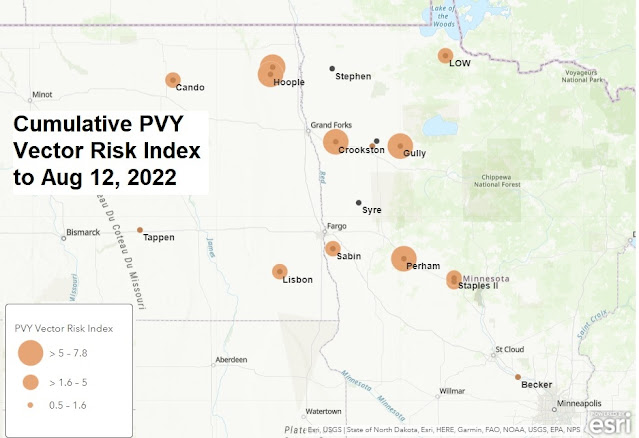Trap Catches to Aug 04 - Aug 11, 2023.
And another big week for aphid flights! Only 11 traps were reporting this week. Several have been negatively impacted by last week's weather and may need some maintenance to get back online. However, with 6 fewer traps reporting, our numbers of vector captures this week is only slightly below that of last week's 17 traps. So, while the average number of vectors captured is slightly lower than last week, the average capture per trap increased by about 30% (average trap catch of all aphids last week was approximately 66/trap; this week's trap captures averaged 92 total aphids per trap). All things considered, it looks like aphid flights ramped up this week. A large part of this week's capture were vector species and, accordingly, the PVY Vector Risk Index took a large jump.
All traps reporting collected soybean aphids this week, some at very high numbers. Three geographically separated sites sites reported green peach aphids this week, although only single individuals. Very high numbers of English grain aphid were captured again this week, trap locations close to small grain production areas were hit pretty heavy and suffered an increase in PVY risk. Potato aphids were common as were thistle, cotton/melon, and buckthorn aphids. A variety of other vector species were present in lower numbers. The overall aphid flight included a large number of non-vector species.
This is the second week traps recorded high flight numbers of vector species. This looks very much like the start of a high vector pressure late season. Most of our PVY transmission in MN & ND likely occurs in late season (certainly that is the time of highest vector flight) and higher vector population at that time does increase the potential for disease transmission. Consequently, appropriate measures such as antifeedant insecticides and the use of crop oils should definitely be considered.
The weather next week may be turning a bit warmer. That may mean more flight activity which will increase probing on plants in the field. Those locations close to traps reporting any of the species that colonize potatoes (esp green peach, potato, foxglove, buckthorn, and black bean aphids) should continue to scout for colonies. Although non-colonizing species can be as, or more important vectors of PVY, scouting may not provide good estimates of their potential presence in fields. However, note their presence in local traps in the network and that will provide some indication.
So, you keep scouting and we'll keep counting.




